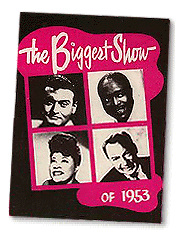|
However, satisfying Savoy lindyhoppers was hardly an excuse
but rather the major strength of the Webb-Fitzgerald combination. In later years Fitzgerald became the vocal star of Jazz at the Philharmonic, the first touring pure-jazz aggregation to make a point of not performing for dancers, but she gained her earliest reputation as, no less than Webb, a musician who fed off the terpsichoric activity of the crowd as much as she inspired it. "Mr. Paganini" (aka "You'll Have to Swing It"), in fact, represents a transmutation of a rhythmic comedy number, originally written and performed in several tempi, into a straight-ahead dance number.
 Similarly, "The Dipsy Doodle," arranger Larry Clinton's hymn to dyslexia, Edgar Sampson's "When Dreams Come True" and "Just a Simple Melody," which sounds like "Stompin' at the Savoy" sung sideways, are such strictly for-dancers-only riff-works that even with Fitzgerald's choruses they still sound like instrumentals. She even fits perfectly into the band's two extended dance spectaculars, "I Want to Be Happy" and "Hallelujah," which work so well in the four-minutes-plus format that they make one wish that all swing band records had been planned as 12-inchers. Similarly, "The Dipsy Doodle," arranger Larry Clinton's hymn to dyslexia, Edgar Sampson's "When Dreams Come True" and "Just a Simple Melody," which sounds like "Stompin' at the Savoy" sung sideways, are such strictly for-dancers-only riff-works that even with Fitzgerald's choruses they still sound like instrumentals. She even fits perfectly into the band's two extended dance spectaculars, "I Want to Be Happy" and "Hallelujah," which work so well in the four-minutes-plus format that they make one wish that all swing band records had been planned as 12-inchers.

 Fitzgerald fits in so well with the Webb-Savoy ideal of "dance-opation" that Webb could turn over more and more of the band's vinyl space to her and never compromise the group's status as Harlem's premiere lindy-hop ensemble. After 1935, numbers with Fitzgerald vocals outnumbered Webb's other records four to one, while she sang on at least half of the tunes on every surviving broadcast. "When Ella Fitzgerald came in, we had to go with the tide," Taft Jordan recalled, lamenting, along with many a swing fan, that the band never had the opportunity to record many of its instrumentals, but, he admitted, "she really put the band over." Fitzgerald fits in so well with the Webb-Savoy ideal of "dance-opation" that Webb could turn over more and more of the band's vinyl space to her and never compromise the group's status as Harlem's premiere lindy-hop ensemble. After 1935, numbers with Fitzgerald vocals outnumbered Webb's other records four to one, while she sang on at least half of the tunes on every surviving broadcast. "When Ella Fitzgerald came in, we had to go with the tide," Taft Jordan recalled, lamenting, along with many a swing fan, that the band never had the opportunity to record many of its instrumentals, but, he admitted, "she really put the band over."
 Equally important, the percentage of each individual record given over to Fitzgerald increased correspondingly: on the first few sides, she only sings the brief, 32-bar vocal refrain most bandsingers had to be satisfied with on a handful of occasions. As early as "Rhythm and Romance" and "Under the Spell of the Blues," Fitzgerald returns for 16-bar outchoruses near the codas of most of the Webb records. Further, on "Mr. Paganini," "Vote For Mr. Rhythm" and many more, it's Fitzgerald who states the main melody in the opening chorus, not the band, while on "Sing Me a Swing Song," "F. D. R. Jones" and others, she even gets to sing the verse - something practically unheard of on a dance band record. This amounted to more than a simple series of concessions to the popularity of a star vocalist - as Harry James would later do for Frank Sinatra and Helen Forrest, for example - because Fitzgerald's vocals satisfied the demands of the dancers as adequately as anything else the band could do. Equally important, the percentage of each individual record given over to Fitzgerald increased correspondingly: on the first few sides, she only sings the brief, 32-bar vocal refrain most bandsingers had to be satisfied with on a handful of occasions. As early as "Rhythm and Romance" and "Under the Spell of the Blues," Fitzgerald returns for 16-bar outchoruses near the codas of most of the Webb records. Further, on "Mr. Paganini," "Vote For Mr. Rhythm" and many more, it's Fitzgerald who states the main melody in the opening chorus, not the band, while on "Sing Me a Swing Song," "F. D. R. Jones" and others, she even gets to sing the verse - something practically unheard of on a dance band record. This amounted to more than a simple series of concessions to the popularity of a star vocalist - as Harry James would later do for Frank Sinatra and Helen Forrest, for example - because Fitzgerald's vocals satisfied the demands of the dancers as adequately as anything else the band could do.
 
 This site rescued by media.org. This site rescued by media.org.
|




![]() This site rescued by media.org.
This site rescued by media.org.

